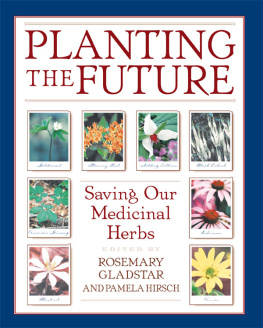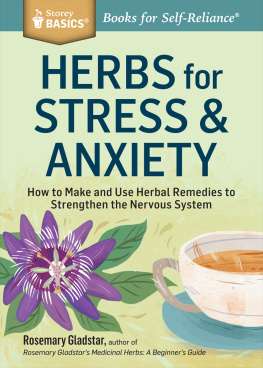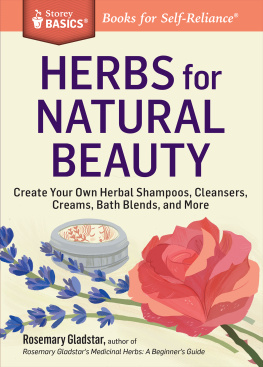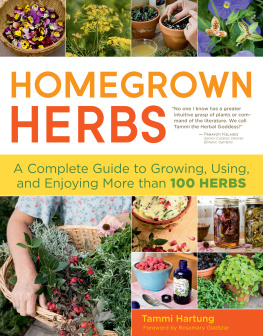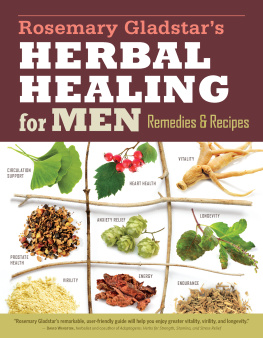
PLANTING
THE FUTURE
Saving Our
Medicinal Herbs

Edited by
ROSEMARY GLADSTAR
and PAMELA HIRSCH

Healing Arts Press
Rochester, Vermont
United Plant Savers lovingly dedicates this book
To our elder teachers, who taught us to love and respect the plants;
To all those future herbalists who will be caretakers of the green;
And to the board members of UpS, past and present, who have committed their lives to the caretaking of the earth and the holy green mantle that covers her. At a time when medicinal plant conservation was often questioned as radical, at times even termed hysterical, this eclectic and visionary group of knowledgeable herbalists, wildcrafters, farmers, medicine makers, and botanists came together to examine the current situation of North American medicinal plants and seek solutions to overharvesting and habitat destruction. Their untiring efforts have made a difference, and this book is a result of their collective dedication:
Christopher Hobbs, Michael McGuffin, Jane Bothwell, Ryan Drum, David Winston, Don Babineau, James Green, Paul Strauss, Steve Phillips, Deb Soule, Sara Katz, Ken Murdock, Richo Cech, Matthais Reisen, Pam Montgomery, Tammi Hartung, Dr. Ethan Russo, Steven Foster, Rosemary Gladstar, and Dr. Richard Liebmann, first executive director of United Plant Savers.
ACKNOWLEDGMENTS

T hough every book is a collective effort of sorts, the fruition of Planting the Future was completely dependent upon a group of fellow beings who have committed their lives fully to the green medicine of plants. All these people contributed their time and expertise with no recompense other than the satisfaction of knowing they were contributing to a worthwhile cause. The list is long. First and foremost our thanks go to Pamela Hirsch. Her tireless and talented editing skills and ever bright personality were the magic that wove more than forty chapters into an inspiring cohesive whole. The beautiful photographs of at-risk plants were generously donated by Martin Wall, botanical photographer and avid supporter of UpS. Richo Cech and David Winston, aside from writing excellent chapters of their own, contributed much expertise and experience in helping others write their chapters with necessary technical data. Christopher Hobbs graciously offered to review the manuscript for technical accuracy. Special thanks are needed for the marathon efforts of Sara Katz, Cascade Anderson Geller, Richo Cech, and Tammi Hartung, who worked together to compile the conservation guidelines; for Kathi Keville for her undaunting support on due day; and for Nancy Scarzello and Richard Liebmann for their continuous efforts toward this project. Wed also like to acknowledge all of the contributors, who in the midst of their busy lives took the time to write informative chapters on their favorite herbs. And, finally, special thanks to Rosemary Gladstar and Deb Soule; it was their initial vision that inspired this book project for United Plant Savers.
United Plant Savers
FOREWORD

RICHARD LIEBMANN, N.D.,
Executive Director, United Plant Savers
A s we enter the new millennium, a twenty-year, sixteen-organization study reports that thirty-four thousand plant species12 percent of plants worldwide and 29 percent of plants in the United Stateshave become so rare that they could easily disappear. This potential catastrophic loss of plant life is directly attributable to loss of habitat caused by urban sprawl and deforestation. Native medicinal plants in the U.S. are additionally being stressed to fuel the skyrocketing growth of the herbal industry both at home and abroad. Worldwide, more than 80 percent of the population uses herbal medicine as their primary form of health care. In the U.S. herbs are a $4-billion-plus industry; worldwide, at least $20 billion. Many of the most important native medicinal plantsthose used for human healing for thousands of yearsare threatened with extinction. United Plant Savers is a nonprofit grassroots membership organization whose mission is to conserve and restore native medicinal plants and their habitats while ensuring an abundant renewable supply of medicinal plants for generations to come. United Plant Savers was formed in the spirit of hope, by people committed to protecting and replanting native medicinal plants and to raising public awareness about the plight of native medicinal plants. United Plant Savers activities include:
- Identifying which native medicinal plants are at risk
- Raising public awareness of the current plight of at-risk native medicinal plants
- Creating and managing botanical sanctuaries
- Providing seeds and rootstock and information for replanting at-risk species
- Replanting and restoring at-risk medicinal plants
- Consulting with those who grow and harvest medicinal herbs regarding sustainable land-use practices
- Sponsoring programs for school systems and communities to replant at-risk medicinal species back into their natural habitats
- Carrying out focused research to help accomplish the above goals
We have many exciting projects. One is working with government, industry, and the public to establish and implement a strategy for the long-term sustainability of goldenseal (Hydrastis canadensis). Another is working at a grassroots level throughout the country sponsoring native plant giveaways; providing small grants for community planting projects; hosting workshops and conferences; establishing the UpS Botanical Sanctuary Network in peoples backyards, farms, and woodlands; and creating a living greenway of native medicinal plants throughout North America.
United Plant Savers recently established its first center on 378 acres of fertile and beautiful land in the Appalachian foothills of southeastern Ohio. This botanical sanctuary serves as a research and education center where many come to interact with and learn about native medicinal plants in their natural habitat. We offer diverse learning opportunities for children, university students, farmers, scientists, and the general public. Research focuses on native medicinal plant population studies, cultivation studies, and wild-harvesting and sustainability studies. The sanctuary also serves as a repository of native medicinal plant germ plasm, as a propagation facility for native medicinal plant seeds and live planting material, and as model of sustainable land use.
With the publication of Planting the Future, United Plant Savers has taken a major step forward in disseminating up-to-date and comprehensive information on conservation, cultivation, and usage of at-risk native medicinal plants. Whats special about this book is that it is a collaborative effort by some of the most respected names in American herbalism. All the contributors are deeply impassioned about native medicinal plants and committed to the health and well-being of these species and their natural habitats.
Our plant brothers and sisters have been essential healers for humans since the beginning. Today the very survival of native medicinal plants is symbolic of the challenge we face as humans. United Plant Savers is taking both the short and long view of protecting native medicinal plants. We understand that the issues are complex, and that much research will be needed if we are to understand the full implications of our present actions. As a grassroots organization, we plan to stay intimately involved with planting and protection efforts across the United States. The words of Margaret Mead ring true: Never doubt that a small group of thoughtful, committed citizens can change the world; it is the only thing that ever has. We all must work together to protect at-risk native medicinal plants. At the same time we must champion sustainable organic cultivation and sustainable wild-harvesting to ensure an abundant, renewable supply of native medicinal plants for future generations.
Next page
